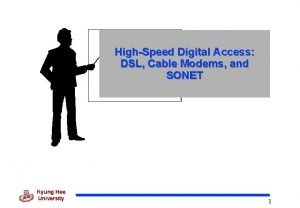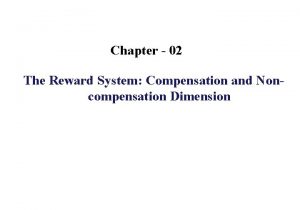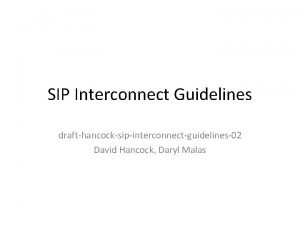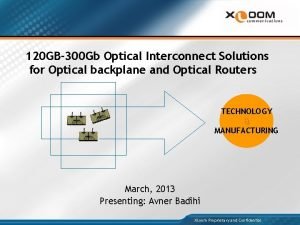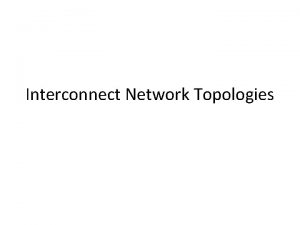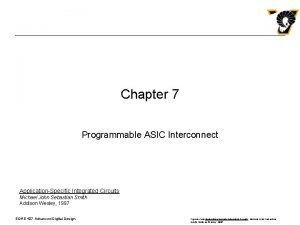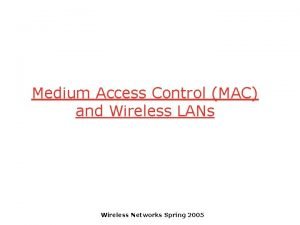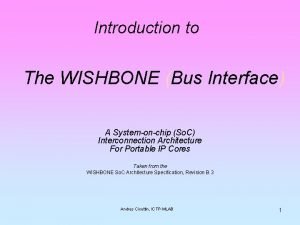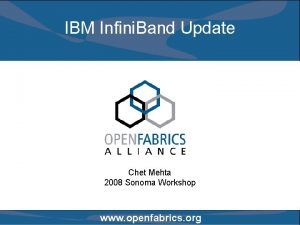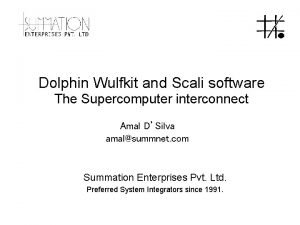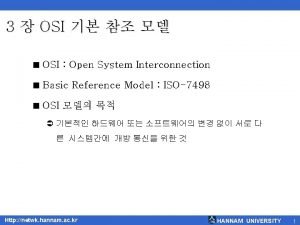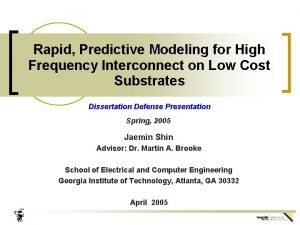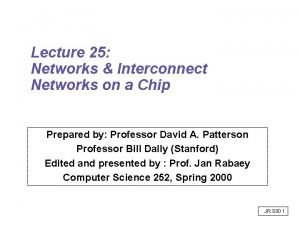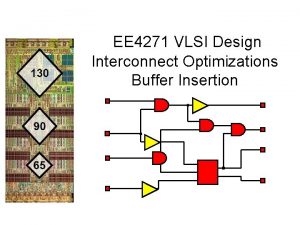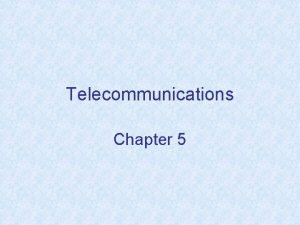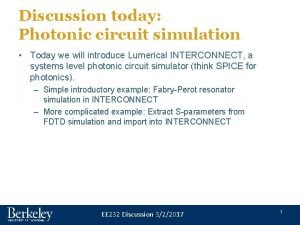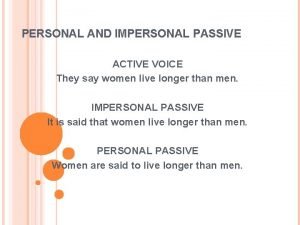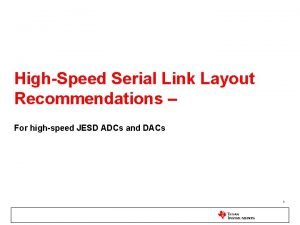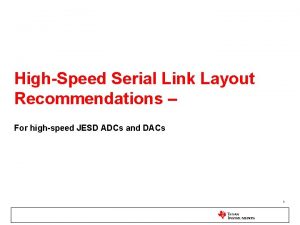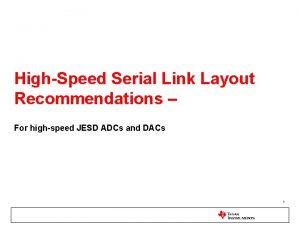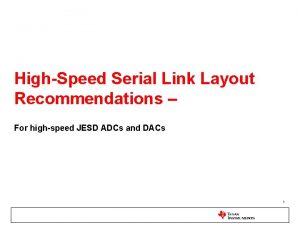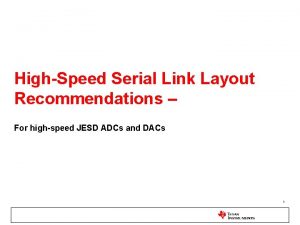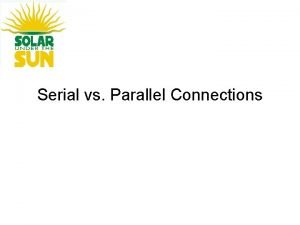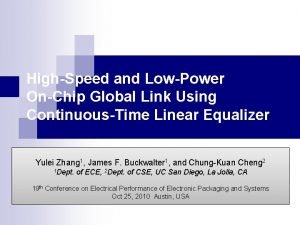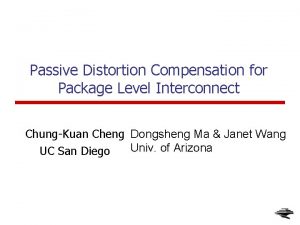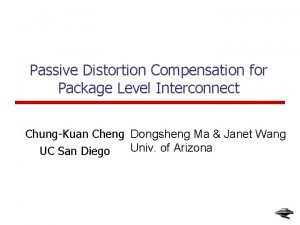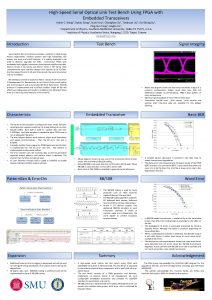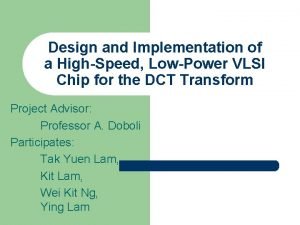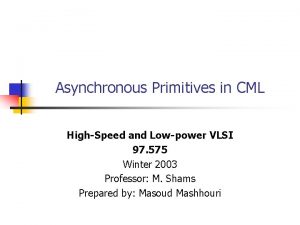LowPower and HighSpeed Interconnect Using Serial Passive Compensation































- Slides: 31

Low-Power and High-Speed Interconnect Using Serial Passive Compensation Chun-Chen Liu and Chung-Kuan Cheng Computer Science and Engineering Dept. University of California, San Diego http: //www. cse. ucsd. edu/~kuan/

Outline l Motivation l Previous Works and Our Contributions l Proposed Passive Compensation Technique ¤ Theory ¤ Experiments: An MCM stripline Case l Analytical Performance Prediction l Experimental Results and Future Work

Motivation l Technology Advancement: Interconnect is one bottleneck of system performance. l Bandwidth Increase: Interchip communication is expected to exceed 15 GHz in 2010. l Low Power Requirement: IO consumes one major portion of chip power budget.

Previous Works Overview l On-chip serial link signaling schemes ¤ ¤ Pre-emphasis and equalization (W. Dally, ’ 98) Clocked discharging (Horowitz, ISVLSI’ 03) Frequency modulation (Wong, JSSC’ 03, Jose, ISVLSI‘ 05) Non-linear transmission line (Hajimiri, JSSC’ 05, E. C. Kan, CICC’ 05) l Passive compensation ¤ ¤ Resistive termination (Hashimoto, EPEP’ 04, Tsuchiya, CICC’ 04, Flynn, ICCAD’ 05, CICC’ 05) Surfliner (C. K Cheng, ASPDAC’ 07)

Published on-chip serial link signaling schemes- Resistive Termination l Use resistive termination to cut the slow RC top Michael Flynn, ICCAD ‘ 05 l Tsuchiya et al. developed an analytical model of eye opening with resistive termination for on-chip transmission line (CICC ’ 05)

Published on-chip serial link signaling schemes- Surfliner l Use shunt resistors to reduce loss tangent and maximize eye-opening and minimize jitters. Haikun Zhu et al. Aspdac’ 07 l Haikun Zhu et al. developed an analytical model for eye opening with shunt resistors.

Our Contributions l The main advantages of this work ¤ ¤ ¤ Adopt a novel serial passive impedance scheme to reduce the power consumption and improve the bandwidth. Derive eye prediction methods using bitonic assumption. Propose a new interconnect scheme with wide band working frequency. l Our proposed scheme ¤ MCM interconnect using parallel resistor and capacitor as equalizer.

Problem Formulation and Design Flow l Problem Formulation ¤ ¤ Input: T line with R(f), L(f), G(f), C(f) (IBM EIP). Output: Best Zd to maximize the eye diagram. l Design Flow 1. 2. 3. 4. Set Rd = Rskin- Rdc, Repeat steps 3, 4 with tuned Cd to maximize eye-opening Generate step response using HPSICE. Predict eye diagram using step response.

Theory Analytical -Bitonic Step Response Assumption l Bitonic step response assumption ¤ ¤ A step response that monotonically increases to its peak and then monotonically decreases to saturation voltage. We use three parameters V 1, Vmax and Vsat to predict the eye diagram.

Theoretical Analysis l Telegrapher’s equations l Wave Propagation l Propagation Constant l Characteristic Impedance l and correspond to attenuation and phase velocity. Both are frequency dependent in general.

Implementation l Interconnect Scale On-chip MCM Board Length 10 mm 10 cm 25 cm Series Resistance at DC 10Ω/mm 1Ω/mm 0. 01Ω/mm Cross Section Dimension 1μmx 1μm 8μmx 4. 5μm 4 milx 1. 2 mil Dielectric Material Si. O 2 Ceramic FR 4 Dielectric Constant 3. 9 3. 4 Loss Tangent 0. 00068 0. 0018 0. 016 Frequency dependency Small Large Significant Operation Region RC RLC Skin depth of pure copper 0. 66 μm @ 10 GHz

Experiment Setting: • Geometry is based on IBM high-end AS/400 system. • Line length = 10 cm.

Step Response with Rd and Rt (10 segments)

Step Response with Rt (10 segments)

Step Response with Zd and Rt (10 segments)

Eye-height/jitter vs Rd and Cd (10 Gbps)

Eye Diagram – Zd, Rt 30 Gbps with Cd=0. 41 e-12, Rd=141, Rt=74 Vheight= 0. 303 V, Jitter; 2. 41 ps

Eye Diagram- Zd , Rt 40 Gbps with Cd=0. 31 e-12, Rd=168, Rt=74 Vheight= 0. 23 V, Jitter= 2. 1 ps

Eye Diagram- Zd, Rt 50 Gbps, with Cd=3 e-13, Rd=193, Rt=74 Vheight= 0. 21 V, Jitter= 4. 21 ps

Eye Diagrams- Zd, Rt 100 Gbps with Cd=1 e-13, Rd=247, Rt=74 Non-Distinguishable

Eye Diagrams - Rt 30 Gbps with Rd= 0, Rt=70 Vheight= 0. 188 V, Jitter= 13. 78 ps

Eye Diagrams - Rt 40 Gbps with Rd= 0, Rt=70 Vheight= 0. 07 V, Jitter= 15. 59 ps

Eye Diagrams – Rd, Rt 10 Gbps, Rd=74, Vheight= 0. 269 V, jitter=7. 03 ps

Eye Diagrams – Rd, Rt 20 Gbps, Rd=74 Vheight= 0. 163 V, jitter=10. 04 ps

Eye Diagrams – Rd, Rt 30 Gbps, Rd=74 Vheight= 0. 103 V, jitter=15. 01 ps

Eye Diagrams – Rd, Rt 40 Gbps, Rd=74 Vheight= 0. 043 V, jitter=16. 2 ps

Experimental Results Rd= Rskin-Rdc, Rdc=50 ohm

Optimal solution, and power consumption comparison l Achieve lowest power consumption. l Reach up to 50 Gbps with open eyes.

Compared predicted Eye-high with HSPICE

Future Work l Automate the synthesis. l Prototype & measurement. l Incorporate transmitter/receiver. l Applications: clock trees, buses.

Q/A Thank You
 Highspeed test
Highspeed test Highspeed dsl
Highspeed dsl Compensation and non compensation dimensions
Compensation and non compensation dimensions Pipo truth table
Pipo truth table What is soap opera
What is soap opera Sip interconnect
Sip interconnect Virtual protocol interconnect
Virtual protocol interconnect Optical interconnect
Optical interconnect Optical interconnect solution
Optical interconnect solution Clos network topology
Clos network topology Programmable asic
Programmable asic Rating group in telecom
Rating group in telecom Cross building interconnect
Cross building interconnect Hyper transport
Hyper transport Wishbone interface
Wishbone interface Sonoma interconnect
Sonoma interconnect Dolphin interconnect
Dolphin interconnect Open systems interconnect
Open systems interconnect High frequency interconnect
High frequency interconnect Interconnect
Interconnect Interconnect
Interconnect Dspx simulation suite
Dspx simulation suite Flexible interconnect system
Flexible interconnect system Interconnect
Interconnect Ring interconnect
Ring interconnect Lumerical interconnect
Lumerical interconnect Present perfect continuous passive form
Present perfect continuous passive form It is believed passive voice
It is believed passive voice The passive voice simple present and simple past
The passive voice simple present and simple past What is passive
What is passive Present simple passive vs present continuous passive
Present simple passive vs present continuous passive Cms compensation rules for msa and pdp
Cms compensation rules for msa and pdp
